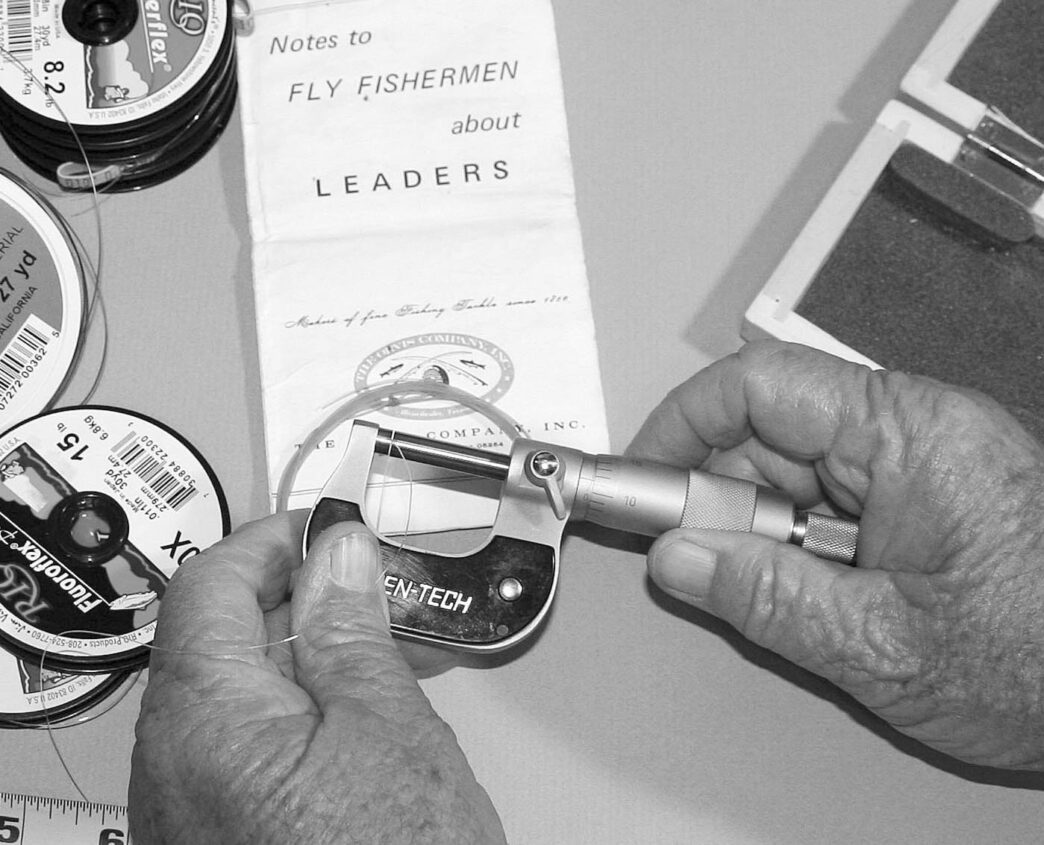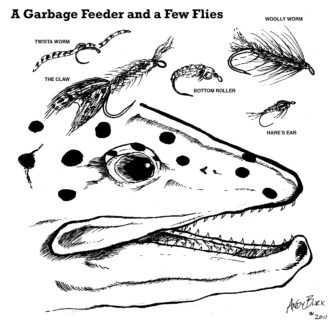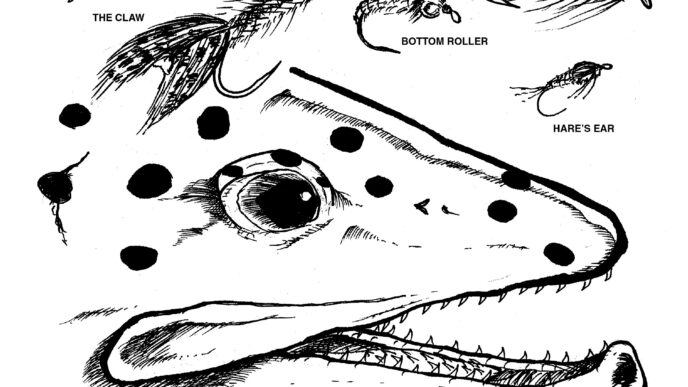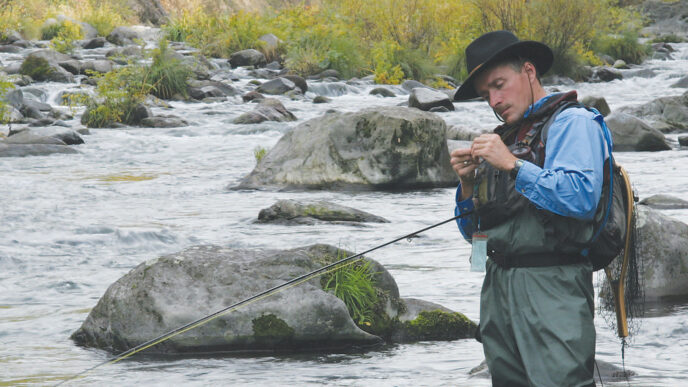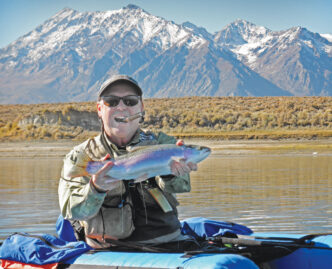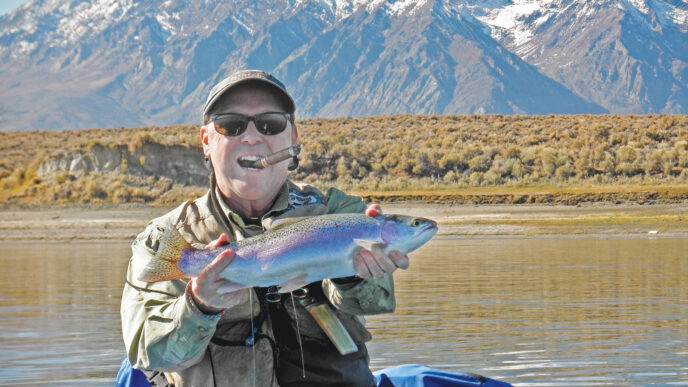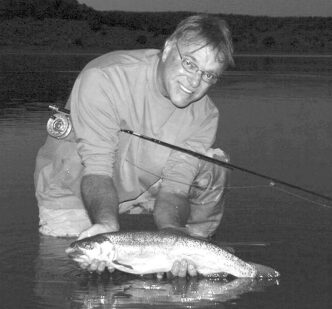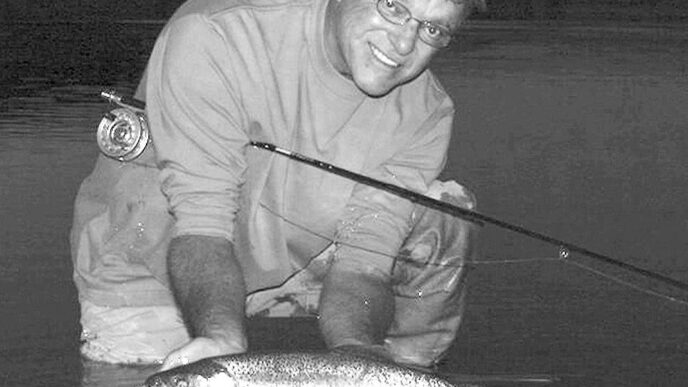The finely tapered trout leader is a thing of beauty, so slender that it nearly vanishes on the water, a dainty dry fly attached to its end. It’s tempting to say a bass leader, in comparison, is pug-ugly, but if beauty is a result of form following function, then the short, stout leaders designed for casting bass bugs might be considered darn pretty, as well.
A bass-bug leader is, by necessity, a lot bigger than a trout leader. I don’t mean longer, but built of sterner stuff. While a typical trout leader may have a butt section measuring around .021 inches in diameter, with a smooth taper down to as fine as 6X or so (that’s .005 inches, with ordinary monofilament testing at approximately 3 pounds), a quite ordinary bass-bug leader designed to let you fish a decent-sized bass bug in a typical environment where bass thrive may start at the aforementioned .021 inches at the line/leader connection, but if it tapers at all, the terminal end, where the bug is tied, often measures something like .015 inches. With ordinary mono, that tests at around 28 pounds. Delicate it ain’t.
A friend of mine, picking up one of my bass rods and examining it, remarked, “That’s not a leader, that’s a rope.” He also said he thought my bass-bug rod, a 9-foot fiberglass rod that tosses an 8-weight line, was “a club.”
Well, he’s right. A good bass-bug leader, capable of carrying the energy of a hefty weight-forward or bass-bug taper line of at least 7 weight and of handling the wind resistance of a bass bug as heavy as a small box full of dry flies, a bug with a diameter of more than half an inch, is a rope of sorts. It’s also a nice piece of engineering that does the job described above and still allows the bug enough flexibility to wiggle, gurgle, and otherwise entice a bass to eat it. A well-engineered bass leader will also get your bug back when you toss it into the branches of a halfdrowned oak tree or inside the tule-reed domain of a big bass who lives there because it provides a safe haven from all sorts of predators, including guys with fly rods and bass bugs.
For most uses, a typical leader starts at the line end with a butt section designed more or less to match the diameter of the tip of your fly line. Since most leader-tying instructions dictate you step down in diameter in increments of .002 inches to maintain a smooth transition from thick to thin, you need to be able to measure the tip of your fly line so you have a starting point. For that, you need a measuring tool. Since you are dealing in small diameters and thousandths of an inch, the proper tool is a micrometer.
A micrometer is a tool used for checking the diameter of machined parts to less than a thousandth of an inch. More properly speaking, we’re dealing with an “outside micrometer,” since micrometers are also made for measuring the inside of things. You aren’t going to be machining your leaders on a lathe, though, so you don’t have to drop a couple of hundred dollar bills on the counter to get an adequate micrometer for the job at hand.
For general use and even for carrying in your tackle box or vest, there’s a nice little go-no-go type of gauge called the Mike-Rite. Designed by Ned Grey, it has finely machined slots that allow you to check the diameter of a strand of mono or anything else that will fit the slot — I’ve used mine to check the thickness of fly-tying materials. It’s pretty inexpensive, too, less than twenty dollars at most fly shops. I recently found a similar tool manufactured by Fishpond in a fly-fishing catalog.
Orvis used to offer the Leonard Line Mike, a pocket-sized dial micrometer that, as I recall, would measure things of about a quarter inch and smaller. It was a bit expensive, and I haven’t seen one in years. They were very nicely made, though, and if you run across one at a yard sale, consider buying it.
If you need a micrometer for measuring more than leader material, you should purchase one of the machine-tool types that can measure materials an inch or more in diameter (which can be handy when building fly rods), but will also measure tiny diameters of leader material. I bought one of these micrometers at an outlet store called Harbor Freight and Tool. It also cost less than twenty dollars.
While I am plugging sources and gadgets, let me also put in a word for a couple of books that cover the subject of bass leaders quite well. One is the fine handbook Fly Fishing for Bass, written and illustrated by Dave Whitlock (Lyons Press, 1988). Another good beginner’s book is Bassin’ with a Fly Rod, by Jack Ellis (Mountain Pond Publishing, 1994).
Let’s exclude fluorocarbon from this discussion, mostly because I don’t often use it for when creating leaders for bass and stripers. It’s not that I don’t like the material; it makes excellent tippets for fine dry-fly and nymph leaders. I just don’t use it much for bass bugs because it costs a lot more than monofilament, and neither largemouth bass nor striped bass have shown much of a tendency to be leader shy. That said, though, I do have a roll of fluorocarbon in size 0X (15-pound test), with which I have tied leaders for medium-sized bass poppers.
I have tied in the past and will continue to tie a number of tapered bass-bug leaders using Mason Hard Nylon leader material for the butt section. It’s stiff and springy and is often recommended for use in tying weed guards on bass bugs. It does both tasks well. Most mono that comes in bulk spools for use with spinning or baitcasting tackle is far too limp for throwing bass bugs and big streamers. If you purchase machine-tapered leaders, you’ll quickly discover that many of them are a bit on the soggy side at the butt (perhaps OK for trout flies, but not for bass bugs). Ditto for at least some of the coils of leader material sold for tying your own leaders.
That doesn’t mean you can’t purchase machine-tapered leaders with the required butt stiffness — you can. It’s just that you have to shop around a bit and find brands and sizes that suit your casting, line weight, and situation.
If you hand tie your own leaders, you get a couple of advantages and disadvantages. One advantage is that tying your own leaders allows you to customize them to your lines and flies. If I wish, I can up the weight and stiffness of a leader or make it lighter to match a particular kind of fly I want to cast.
Of course, the simplest of leaders is just a length of untapered mono or fluoro-carbon material tied between the end of the line and your bass bug or streamer. It doesn’t cast as well as a properly tapered leader, but then, casting a hefty bass bug or a sodden streamer fly isn’t particularly graceful anyway. Lefty Kreh writes that he prefers to fish properly tapered leaders with bass bugs. If I could cast anything like Lefty Kreh, I probably would use tapered leaders more than I do. On the other hand, an untapered leader has the qualities of being cheap to make, quick to tie on, and easy to replace. It doesn’t necessarily hamper the way a bug casts, because most bass bugs are horrible to cast really well.
However, I primarily use straight leaders when fishing subsurface flies and almost always when fishing fast-sinking lines and dragging the fly through the depths with a trolling motor. It doesn’t make much sense to fiddle around with tapered leaders for that kind of angling.
My surface fishing is split between tapered and straight leaders. If I can get away with using a leader of a single diameter, then I’ll do so. If I need to cast a tapered leader, then I’ll do so, as well.
I like to create my bass leaders with loop connections at both ends. (Some of you will immediately say the loop will collect debris from the water’s surface, which is true, but I find the ability to change leaders quickly goes a long way to offset this problem.) For the butt end, I attach a loop to the end of the fly line first, then create a loop in the butt of the leader and slide the two together. This makes it easy to remove and replace a leader. For the butt end of the leader, you can create a strong loop with a Surgeon’s Loop Knot or something similar. I generally tie my end loops using the Perfection Loop Knot. I’ve tied it for so many years, I had forgotten what it was called and had to look it up. The way I was taught to tie the knot is quick and easy, but almost impossible to explain in print — so I won’t try. Some anglers will attach the butt section of the leader to the fly line with a Nail Knot, then add (if necessary) sections that will taper the leader to a smaller diameter.
I also like to put a loop at the point in the leader where the tippet goes, because this makes changing tippets easy when they get frayed or nicked by the structure bass are found around. I doubt that it matters where you put loops in your leaders — they will catch on stuff, and you will gripe about it, but they do make it a snap to change your rig when fishing conditions call for it.
I tend to use a Duncan Loop Knot when attaching bass bugs or streamers to the tippet. The open loop lets the fly exhibit additional action in the water, but when a fish takes, the resulting tension slides the knot closed on the hook’s eye, and it is quite strong.
When creating a hand-built leader, I attach the sections to each other with Blood Knots (sometimes called “Barrel Knots”). A Blood Knot creates a tight, slender, and very strong connection. When using small-diameter leader material, however, as when constructing trout leaders, some anglers find tying Blood Knots to be a pain — an actual physical pain, if you have any arthritis in your hands. There are some aids to tying Blood Knots available. I found a couple of them online, but have never tried them, so I can’t comment on their effectiveness. Just do a Google search for “Blood Knot tying tool.”
I much prefer to tie multiple leaders at one sitting, rather than just tying up a single leader. After all, once you get your materials and tools out, it’s almost as quick to tie up half a dozen as it is to tie one. In general, when tying tapered leaders, I follow guidelines from an old leader-tying kit I’ve had for many years. The old mono spools are pretty much used up now, and I purchased a new kit a year or two ago, but the old instructions and formulas for building leaders are good enough, and I am still using them.
A typical bass-bug leader is one of about 7-1/2 feet that starts (for a mediumsized bug) with a butt section of .021-inch material that’s 26 inches in length, I usually cut three or four of these and make each about two inches longer than the required measurement to account for knot tying and the end loop. The next section is 23 inches of .019-inch material, followed by 21 inches of .017-inch material, and finally a tippet of 20 inches of .015-inch material. That gives a fairly stiff butt section, tapering down to a tippet testing 28 pounds. This leader can easily turn over a cork popping bug measuring half and inch or more in diameter, and it has enough guts to get the bug back out of the tules, tree limbs, or other nasty spots.
I know that sounds like a pretty beefy leader, and frankly, most (if not all) of the bass you’ll ever catch won’t stress that much tippet, but the places you throw the bug may. What counts here is that the leader allows you to cast a bass bug with much of the same grace that you experience when fishing for trout with much lighter leaders and flies. If you want, you can delve deeply into the science of leader construction, or if you are like me, just find a suitable set of formulas, tie up a few, and go fishing.




